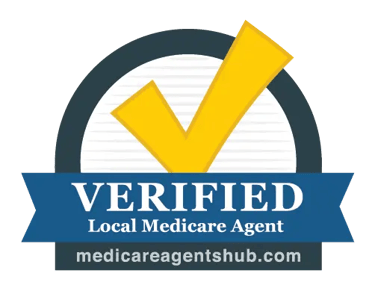Your Medicare Resource Center
Empowering seniors with Medicare information and guidance offered by a Licensed Medicare advisor.
We're not affiliated with any government entity.
★★★★★
What is Medicare?
Medicare is a federal health insurance program primarily designed for individuals age 65 and older, as well as certain younger individuals who qualify due to a disability or end-stage renal disease (ESRD). The program is divided into several parts, with Original Medicare consisting of Part A (hospital insurance) and Part B (medical insurance).
While Original Medicare provides essential coverage, it doesn’t pay for all healthcare costs—beneficiaries are still responsible for deductibles, coinsurance, and other out-of-pocket expenses. To help manage these costs, you have two main options: you can either enroll in a Medicare Advantage (Part C) plan, which replaces Original Medicare and may offer additional benefits, or you can stay with Original Medicare and add a Medicare Supplement (Medigap) policy to help cover the gaps. While Medicare Part D (prescription drugs) is available to you after meeting certain requirements covered below. We can help you better understand your options and help you save on out-of-pocket costs.


Original Medicare & It's Parts
Original Medicare is a federal health insurance program available to most Americans when they turn 65. It includes Part A, which covers hospital care, and Part B, which covers doctor visits and other outpatient services.
While Original Medicare helps with many medical costs, it doesn’t cover everything—services like routine dental, vision, and hearing care are not included.




Medicare Part A
Medicare Part A is hospital insurance that helps cover the cost of inpatient stays in hospitals and skilled nursing facilities. However, it does not cover long-term care or the medical treatments you receive while in the hospital—those services are typically covered under Part B. Each part of Medicare is designed to cover different types of care, so it’s important to understand how they work together.


Medicare Part B
Medicare Part B is medical insurance that helps pay for doctor visits & other outpatient care. It covers two main types of services: medically necessary care & preventive care. Medically necessary services include things like tests, medical equipment, or treatments your doctor needs to diagnose or treat a health condition. Preventive services help catch health issues early and may include screenings, shots, and yearly check-ups.


Medicare Part C
Medicare Part C, aka Medicare Advantage, is a type of health plan offered by private insurance companies. Enrolling in a Medicare Advantage plan is optional. Plans are approved & contracted by the federal government, and must include all the benefits of Medicare Part A & Part B. Many plans also offer extra benefits—like dental, vision, hearing, or prescription drug coverage—but the specific features and costs can vary by plan and provider.
Medicare Part D
Medicare Part D helps cover the cost of prescription drugs and is offered by private insurance companies. If you choose to enroll, you'll pay a monthly premium for your coverage. Part D helps pay for medications you get at your local pharmacy or through mail-order services. In most states, there are dozens of plans available, giving you a variety of options to choose from based on your specific medication needs and budget.
Our services
Provide a general summary of the services you provide, highlighting key features and benefits for potential clients.
Medicare Enrollment Assistance








Medicare Advantage Plans
Medicare Supplement Plans
Stand-Alone Part D
Prescription Plans


Dental, Vision & Hearing Plans






Individual Health Plans
Long Term Care Plans
Extra Help Assistance
Things You Should Know...
Medicare is made up of four distinct parts, each covering different aspects of healthcare. Parts A and B form what’s known as Original Medicare—Part A covers hospital services, while Part B covers outpatient and medical services. Part C, also called Medicare Advantage, is offered through private insurance companies and provides an alternative way to receive your Medicare benefits, often including additional coverage. Part D is the prescription drug benefit, helping to cover the cost of medications.
Original Medicare (Parts A and B) is a federal health insurance program that becomes available to most people when they turn 65. While it provides coverage for many hospital and medical services, it doesn’t cover everything. Important benefits such as routine prescription drugs, dental care, vision exams, and hearing services are typically not included, which may leave gaps in coverage for many beneficiaries.
In most cases, you’ll need to pay a deductible before Medicare begins to cover your healthcare costs. After meeting the deductible, Medicare pays its share, and you’re responsible for any coinsurance or copayments for covered services and supplies.
In addition to Original Medicare, there are optional plans you can enroll in during specific enrollment periods to help cover costs that Medicare doesn’t pay for. These plans, which vary by state, include Medicare Advantage (Part C) plans, Medicare Supplement Insurance (Medigap), and Part D prescription drug coverage. Each option is designed to help reduce out-of-pocket expenses and offer more comprehensive healthcare protection.
Request Our Medicare Guide
Fill out the form below to receive our handy 'Medicare Simplified' guide for you to learn more.


Resources
Learn about Medicare and connect with licensed specialists.
Access our simplified medicare breakdown
info@standardmedicare.com
© 2025. All rights reserved.
DISCLAIMER: StandardMedicare.com is meant to connect you to a Licensed Medicare advisor and provide free educational information to you. Our Licensed Agent does not offer every plan available in your area. Any information provided is limited to those plans we do offer in your area. The most in-depth and up-to-date information about Medicare is available on Medicare.gov. This website is not associated or endorsed by any federal organization, CMS or Medicare.gov. We encourage you to visit Medicare.gov and read the annual publication, Medicare and You. To submit grievances about Medicare Health or Drug plans visit Medicare.gov.
Follow our Instagram
Support
Leonardo Zuniga
Licensed Insurance Agent
NPN# 21569888

